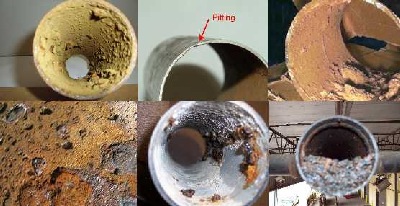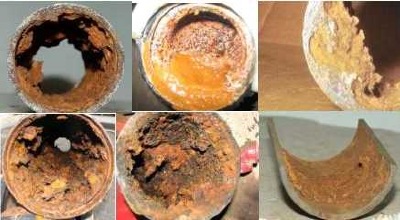




Dry and Wet Sprinkler Systems
The NFPA ranks improper maintenance as the second most common reason for sprinkler system failure, directly behind manually shutting down the system before a fire.
Furthermore, the National Fire Sprinkler Association lists corrosion and freezing as two of the major causes behind sprinkler system failure.
Considering the magnitude of responsibility associated with this system, implementing a Predictive Maintenance program for your fire sprinkler system, addressing issues BEFORE they arise, is critical to keep this important system operating as designed.
 Modern Fire Sprinkler Systems are primarily comprised of two designs, dry and wet systems, each with its own corrosion issues. Sonic Pipe Inspection's patented guided wave scan technology can detect these issues in either system type, described below.
Modern Fire Sprinkler Systems are primarily comprised of two designs, dry and wet systems, each with its own corrosion issues. Sonic Pipe Inspection's patented guided wave scan technology can detect these issues in either system type, described below.
You may be thinking that if you don't see a problem, your system is okay. This may not be further from the truth. Corrosion is often undetectable by external visual inspection. While the dangers of a dripping/bursting pipe are fairly obvious, with water damaging sensitive equipment or data, the internal corrosion can be much more devastating. In the unfortunate event of a fire, corrosion can have three very negative effects on your fire system.
1. The inner diameter of the pipe can be significantly reduced in size by things like corrosion nodules, tubercules, or rust, consequently reducing the amount of water that can flow through this engineered system. As an example, according to the Friction Loss Formula used in the NFPA standard for the installation of fire sprinkler systems, a 1/8" thick layer of corrosion built up in a 2" pipe will double the friction within that pipe. The same layer of corrosion in a 1" pipe will quadruple the friction. The constricted pipe cannot flow enough water to handle the needs of the zone, so the sprinkler heads cannot effectively control the fire in that area, allowing it to grow and spread to other parts of your facility.
2. Debris inside the pipe, such rust, slime, MIL loss, corrosion nodules, etc. can flow with the water to the sprinkler head, clogging the small orifices in the head that create the spray pattern, either forcing an uneven pattern or clogging the head entirely. This exact issue was the cause of a well-documented sprinkler system failure in a nursing home in Iowa. Luckily there were no serious injuries in this instance, but the fire raged out of control, forced a complete evacuation of the building, and significantly damaged a large portion of the facility. Had the system been working as designed, the fire would have been contained to a small laundry room rather than spreading throughout the entire center.
3. Dry system pipe that has been weakened from wall thinning may burst when the system is activated, preventing much needed water from flowing through the system as designed, and allowing the fire to rage out of control.
 Dry
Dry
Sprinkler
Systems
While many may feel that Dry Sprinkler Systems are not susceptible to corrosion due to the "lack of water" present, that is not true. Dry fire systems are very susceptible to aerobic MIC, MIL loss, rust scaling, pitting, and wall loss.
In addition, water pockets are often found in dry systems as a result of water left over from the required NFPA tests (even if the system is blown out with air) and from humidity present in the air inside the pipe. This water then collects in one or more "low spots" within the system, and accelerates corrosion. These low spots exist in pipe due to poor installation practices and typically have accelerated corrosion rates compared to the rest of the system.
Sonic Pipe Inspection is able to map the location of corrosion and water pockets in your Dry Sprinkler System, allowing you to know which areas of your system are in need of further attention.
 Wet
Wet
Sprinkler
Systems
Wet fire systems are very
susceptible to anaerobic MIC, MIL loss, rust scaling, and corrosion build up.
Unlike dry systems, where severe pitting or excessive wall loss can some times be detected visually by dripping water or external rust spots, corrosion in wet systems often remains hidden from the naked eye, within the interior or the pipe.
In
addition, air pockets are often found in wet systems as a result of air bubbles, dissolved in the water, collecting in one or more "high spots" within the
system. These high spots exist in pipe due to poor installation
practices or logistical requirements (i.e. following the slope of a roof line), and typically have accelerated corrosion rates compared to
the rest of the system.
Sonic Pipe Inspection is able to map the
location of corrosion and air pockets in your Wet Sprinkler System,
allowing you to know exactly which areas of your system are in need of further
attention and which areas are still good.